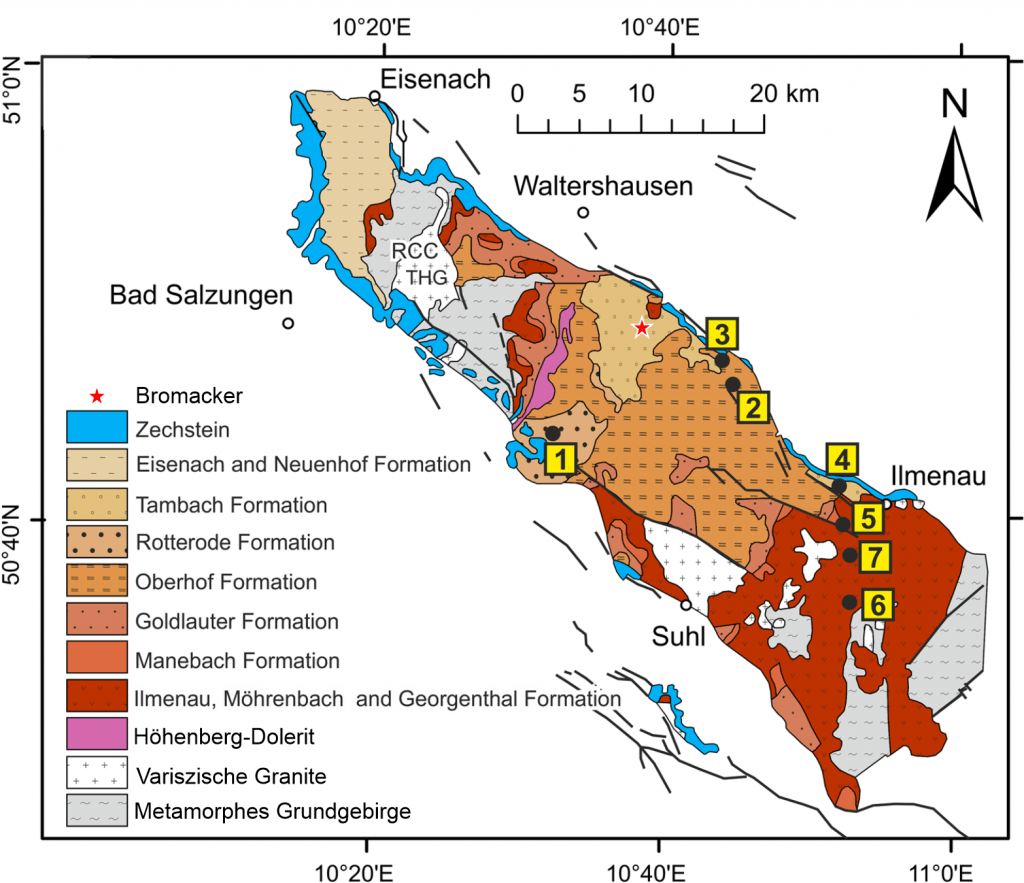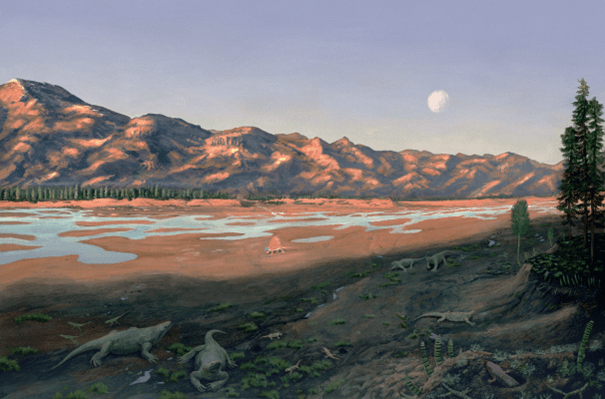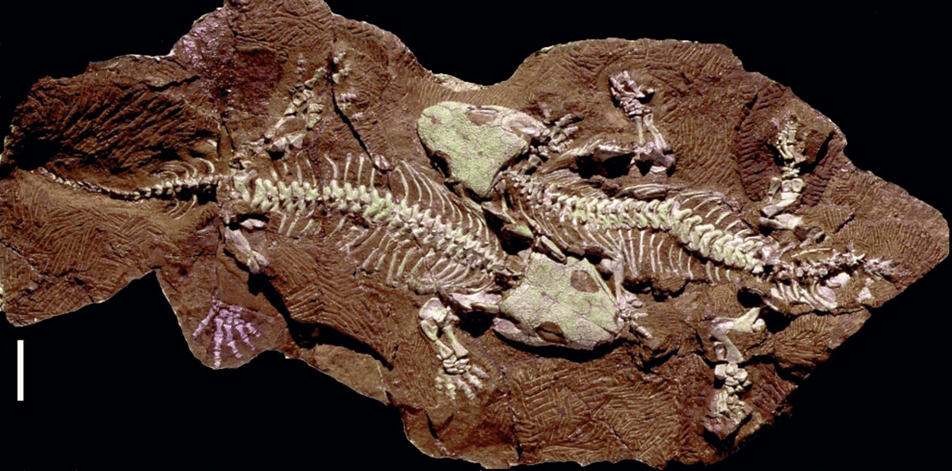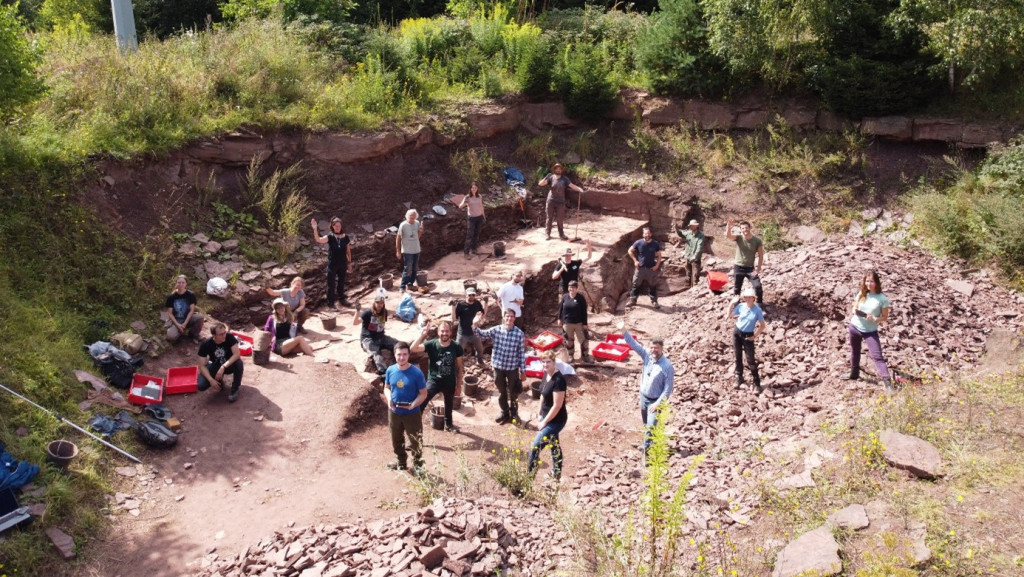TL;DR (Too long; did’nt read)
The Bromacker is a fossil site for early Permian vertebrates, which are preserved here three-dimensionally and often completely. The ecosystem with many herbivores and few predators (similar to today) and the possibility to find trace fossils and their producers next to each other makes this site unique compared to other fossil sites of similar age. This is why it is part of the UNESCO Global Geopark Thüringen Inselsberg-Drei Gleichen and also the subject of ongoing research, which can be visited on site or online.
Overview
The Bromacker is located in the beautiful Thuringian Forest, south of Gotha, to the north of the small town of Tambach-Dietharz. It is part of the UNESCO Global Geopark Thüringen Inselsberg-Drei Gleichen. The special feature of the Bromacker are the fossils found there, which make it a world-class fossil site, but more on that later.
Geologically, the Thuringian Forest is dominated by rocks of the Upper Carboniferous and the Rotliegend (Lower Permian) (see Figure 1). The rocks of the Bromacker are part of the Tambach Formation, in which conglomerates, sandstones and siltstones/clays predominate. Older formations of the Thuringian Forest contain large amounts of volcanic rocks, but these have not yet been described in the Tambach Formation. For this reason, precise age dating is available for many of the older formations, placing their age at 300-296 million years. However, the Tambach Formation and thus the rocks of the Bromacker are not absolutely dated. This and other statements about the depositional conditions of the rocks are part of current research.

Habitat
The creatures found at the Bromacker lived in the Tambach Basin, which was probably a small valley between the Variscan Mountains, which were being eroded, and older volcanic structures. Within this small valley flowed rivers that did not carry water all year round. Between river courses existed extensive alluvial plains on which conifers and other smaller plants grew. In the alluvial plains there were short-lived lakes or rather pools, which is supported by fossils of ostracods and freshwater jellyfish, but the complete absence of fish fossils (see Figure 2). The climate is currently the subject of intense discussion and research.

Fossils
The fossils are the real highlight of the Bromacker. In addition to many trace fossils and fossils of invertebrates such as insects or the freshwater jellyfish already mentioned, it is above all the skeletons of terrestrial vertebrates that arouse the interest of scientists. These are three-dimensional and often even preserved completely articulated. A particularly well-known fossil is the “Tambach Lovers”, two specimens of fossils of the genus Seymouria sanjuanensis found side by side (Figure 3). Many of the Bromacker’s species are otherwise only known from the USA, like the well-known Dimetrodon (even if the one from Bromacker is far smaller than its north-american cousin).

But apart from the very good preservation, the fossil assemblage of the Bromacker has other special features that make it unique. For example, the Bromacker is the only site of Palaeozoic fossils where traces and their producers can be found together and related. In addition, the Bromacker is the first site to show an ecosystem in which a large number of herbivores lived with few predators, similar to today’s ecosystems. This is not known from other sites of terrestrial vertebrates from the Early Permian. Moreover, the excellent preservation in combination with the trace fossils found allows us to draw conclusions about the movement and feeding behaviour of the animals.
This is also interesting from an evolutionary point of view. When the animals of the Bromacker ecosystem inhabited the earth, the lineages of amphibians, reptiles and mammalian ancestors were just separating. So some of the species found at the Bromacker can be seen as our distant ancestors.
Research history
The sandstones at Bromacker have been popular work stones for centuries and were therefore quarried in several quarries. In the process, footprints of invertebrates were discovered, which have been scientifically studied by Prof. Wilhelm Pabst since 1890 at the latest.
When Thomas Martens examined the rocks of the Bromacker in 1974, he found the first bone in the siltstones, which lie between the sandstones and were uninteresting for mining. The find was unexpected, as red bed sediments (to which the rocks of the Tambach Formation belong) were known to contain precisely no fossilised bones and body fossils. However, further excavations showed that fossilised skeletons could indeed be found at the Bromacker. Further excavations in the following years revealed the first coherent skeletons of various genera. These were so important that there were contacts with researchers from the USA even before 1990. From 1993 onwards, scientists from the Carnegie Museum of Natural History in Pittsburgh were involved in excavations at the Bromacker itself. During this time, many species were described for the first time. From 2010, however, work on the Bromacker was suspended for the time being.

The BROMACKER project has been running since 2020 and annual excavations are again taking place (Figure 4). Researchers from the University of Jena, the Stiftung Schloss Friedenstein Gotha, the Museum für Naturkunde Berlin and the UNESCO Global Geopark Thüringen Inselsberg-Drei Gleichen are working together on this project. Research boreholes are also being drilled to better characterise the environmental and depositional conditions; the most recent reached a final depth of 250 metres.
Within the framework of the new project, we are using modern methods that were not available during earlier excavations. 3D imaging is very helpful, be it of individual finds or structures, through outcrop images for better accessibility and documentation, to complete 3D modelling of the site as well as the entire Tambach Basin with the location of various finds or rock units in space. In this way, the scientists hope to gain a better understanding of the living and embedding conditions of the fossils at this special site around 290 million years ago.
Another important aspect of the project is the transfer of knowledge and the involvement of the public. That’s why you can also visit us at the excavation and this year’s borehole in the summer, as well as on certain dates at Schloss Friedenstein in Gotha or at the Museum für Naturkunde Berlin.
Finds from the excavations and other exciting exhibits can be seen all year round, especially in the museum in Gotha, but you can also participate in the current developments at the Bromacker virtually on the website www.bromacker.de or on Instagram at bromacker_chroniken. You can also find the dates of the events mentioned here ->

3D models
References
Lützner, H., Tichomirowa, M., Käßner, A., & Gaupp, R. (2021). Latest Carboniferous to early Permian volcano-stratigraphic evolution in Central Europe: U–Pb CA–ID–TIMS ages of volcanic rocks in the Thuringian Forest Basin (Germany). International Journal of Earth Sciences, 110, 377-398.
Lützner, H., Andreas, D., Schneider, J. W., Voigt, S., & Werneburg, R. (2012). Stefan und Rotliegend im Thüringer Wald und seiner Umgebung. Schriftenreihe der Deutschen Gesellschaft für Geowissenschaften, 61, 418-487.
Martens, T. (2018). Scientific Importance of the Fossillagerstätte Bromacker (Germany, Tambach Formation, Lower Permian)-Vertebrate Fossils: Wissenschaftliche Bedeutung Der Fossillagerstätte Bromacker (Deutschland, Tambach-Formation, Unteres Perm)-Wirbeltierfossilien. Cuvillier Verlag.
Stubenrauch, J., & Mücklisch, M. (2020). Neue Einblicke in die Geologie des Tambach-Beckens (Rotliegend, Thüringen) mit Hilfe von 3D-Aufschluss-Modellierung. Beiträge zur Geologie von Thüringen NF, 26, 235-251.

